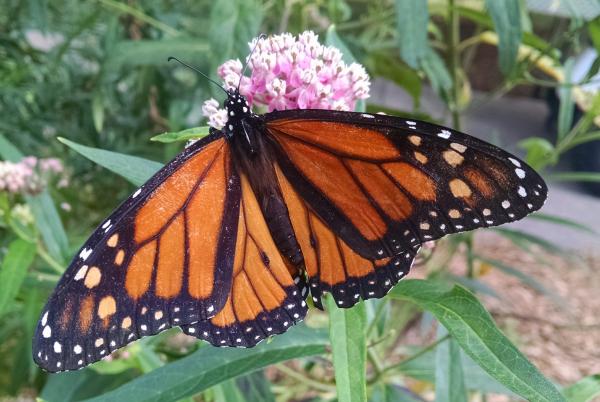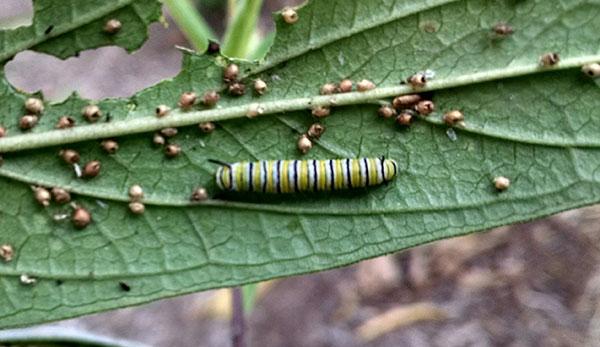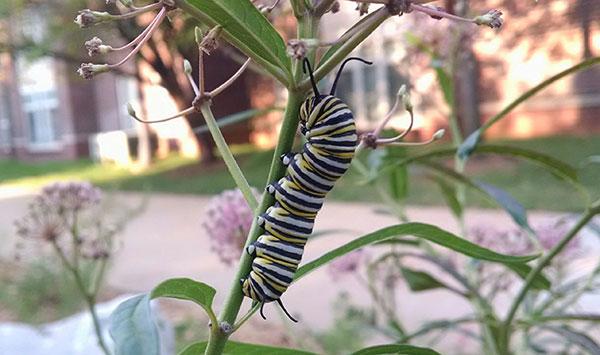Magnificent Monarchs
 Last year, my 7 year old son found a Monarch caterpillar and brought it home. We put it in a jar with some leaves and sticks, then looked up how to care for it. We found out that Monarchs only eat plants in the Milkweed genus (Asclepias). I have been a longtime fan of Common Milkweed since I first smelled its blossom in Virginia. I found some on a roadside, and also would harvest it from a patch on campus. Over the next week or so, that caterpillar ate and ate and grew and grew. Knowing little about the life cycle of a Monarch, and having never seen it first hand, I didn't know the miracle I would witness.
Last year, my 7 year old son found a Monarch caterpillar and brought it home. We put it in a jar with some leaves and sticks, then looked up how to care for it. We found out that Monarchs only eat plants in the Milkweed genus (Asclepias). I have been a longtime fan of Common Milkweed since I first smelled its blossom in Virginia. I found some on a roadside, and also would harvest it from a patch on campus. Over the next week or so, that caterpillar ate and ate and grew and grew. Knowing little about the life cycle of a Monarch, and having never seen it first hand, I didn't know the miracle I would witness.
A Monarch Migration
In fall 2003, here in Springfield, Missouri, I was one day working on a landscape install at a commercial site. As I worked into the morning, a northerly breeze began to pick up making it a very pleasant day. At some point I noticed a Monarch butterfly go by. For all of us in grounds, wildlife is just a part of the job. Shortly I noticed another. Then another. At some point there were enough going by that it finally settled in my brain I was witnessing the Monarch migration. I had heard about this phenomenon somewhere, and only this endless parade of orange and black had jogged my memory and made me aware. It was amazing.

Young Monarch (1/2 long) and eggs on Milkweed leaf.
First Visitors
Since summer 2012, Drury University has been planting several hundred native perennials each year. These native plants are meant to be durable, beautiful, and supportive of the native ecosystem. We see birds and pollinators enjoying these various plants, but we had never seen Monarchs. This spring we installed a new native planting in a residential area, and as part of the planting palette installed 25 marsh Milkweed, Asclepias incarnata, even though I don't recall expressly trying to entice Monarchs. Later, while touring this area with my boss, he asked if we had any caterpillars on the plants. At first I only saw one, but as my eyes realized what they were seeing, I saw about 15 on one plant. This was one of the most satisfying moments of my time here on campus. Our efforts were paying off.
Monarchs and the Campus Landscape
Drury Grounds seeks to be ecologically appropriate while landscaping the campus. The Monarch Butterfly provides a great opportunity for furthering this effort. Most people that will visit us at Drury are acquainted with the Monarch. I cannot imagine anyone who would not support installing plants and habitat to support Monarchs. This is not the case for most of the organisms that play a vital role in the health of our landscapes. In a recent TurfNet webinar, Dr. Dan Potter, UKY, called the Monarch the Bald Eagle of butterflies. This sums up the image and broad appeal of this insect. Making the Monarch the poster child for your restoration efforts almost assures improved support for them. The great synergy is that many other benefits are accomplished by improving Monarch habitat including utilizing natives, providing pollinator foods, improving aesthetics and maybe even creating a venue for community education.

Mature Monarch Caterpillar (2) nearing pupation.
Challenges to the Monarch
The Monarch faces several challenges to its population. Winter habitat in Mexico is being logged. Development and pollution in the U.S. and Canada are stressing the Monarch. In our industry, the use of landscape chemicals is perceived by many as having a significant negative impact on the Monarch among other beneficial insects.
I recently watched an excellent webinar on TurfNet titled Bees, Pesticides and Politics: Challenges and Opportunities for the Green Industry by the aforementioned Dr. Potter. My first takeaway from this webinar was the correct and appropriate use of landscape chemicals diminishes the possibility of non-target impacts, and also helps prevent the paranoia that sometimes surrounds landscape chemical use. The other takeaway is that by voluntarily employing a strategy to accommodate and even support pollinators (support of the Monarch comes along for free), the Grounds Crew can be seen (correctly) as an advocate for the environment rather than a potential threat.
Truly a Miracle
After a short time in its chrysalis, my son's Monarch emerged. To see a newly transformed Monarch is to see a miracle. I can think of nothing man has ever made that can utterly and entirely changes itself into as beautiful a creature. Yet all of us in landscaping have the chance to see such wonder almost every day since we always deal with nature. Seeing this year's Monarch caterpillars on campus gave me much the same fulfillment. Wonderful.
* * *
In addition to viewing Dr. Dan Potter's TurfNet Webinar, I recommend viewing this PBS/Nova documentary: The Incredible Journey of the Butterflies.



0 Comments
Recommended Comments
There are no comments to display.